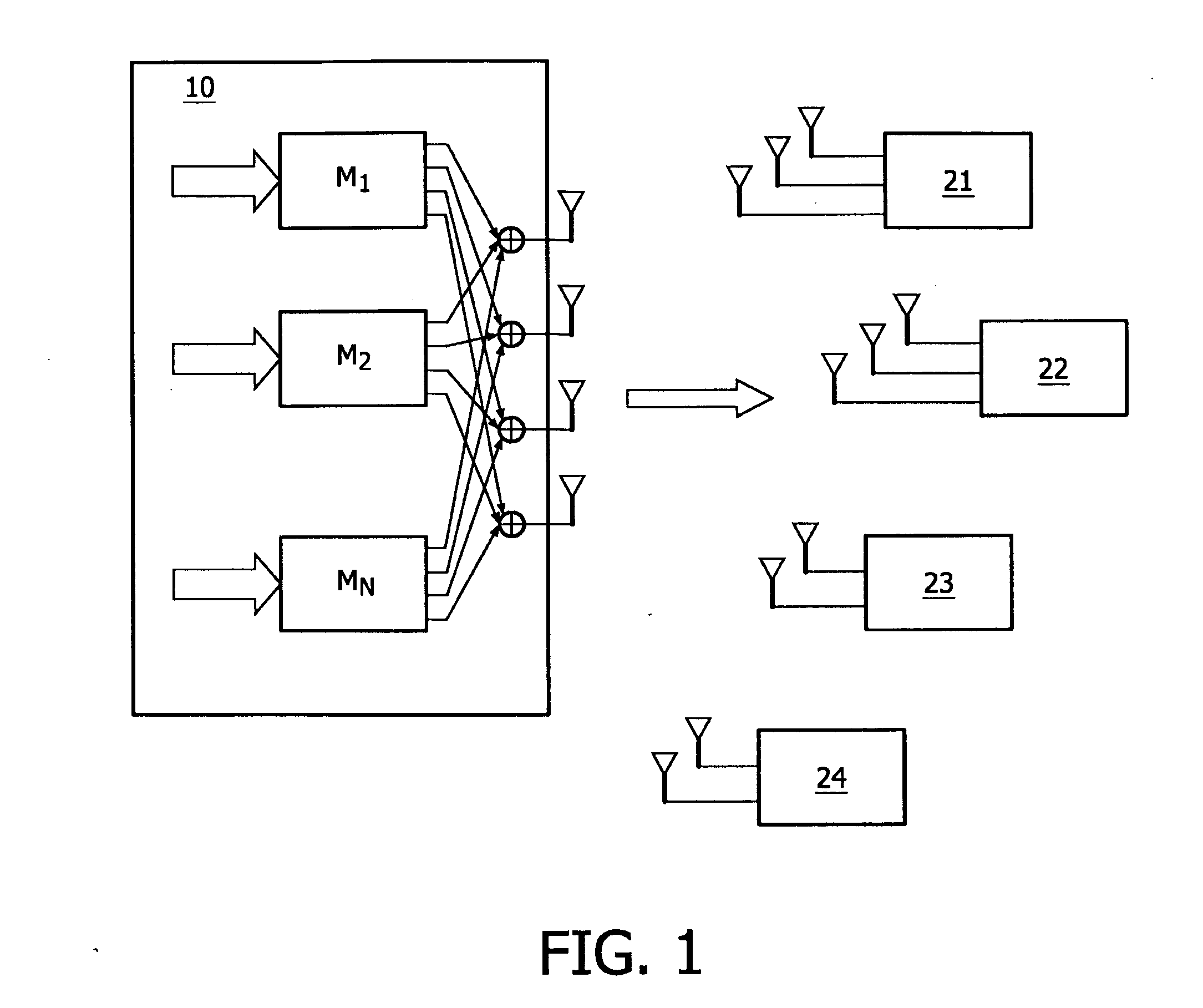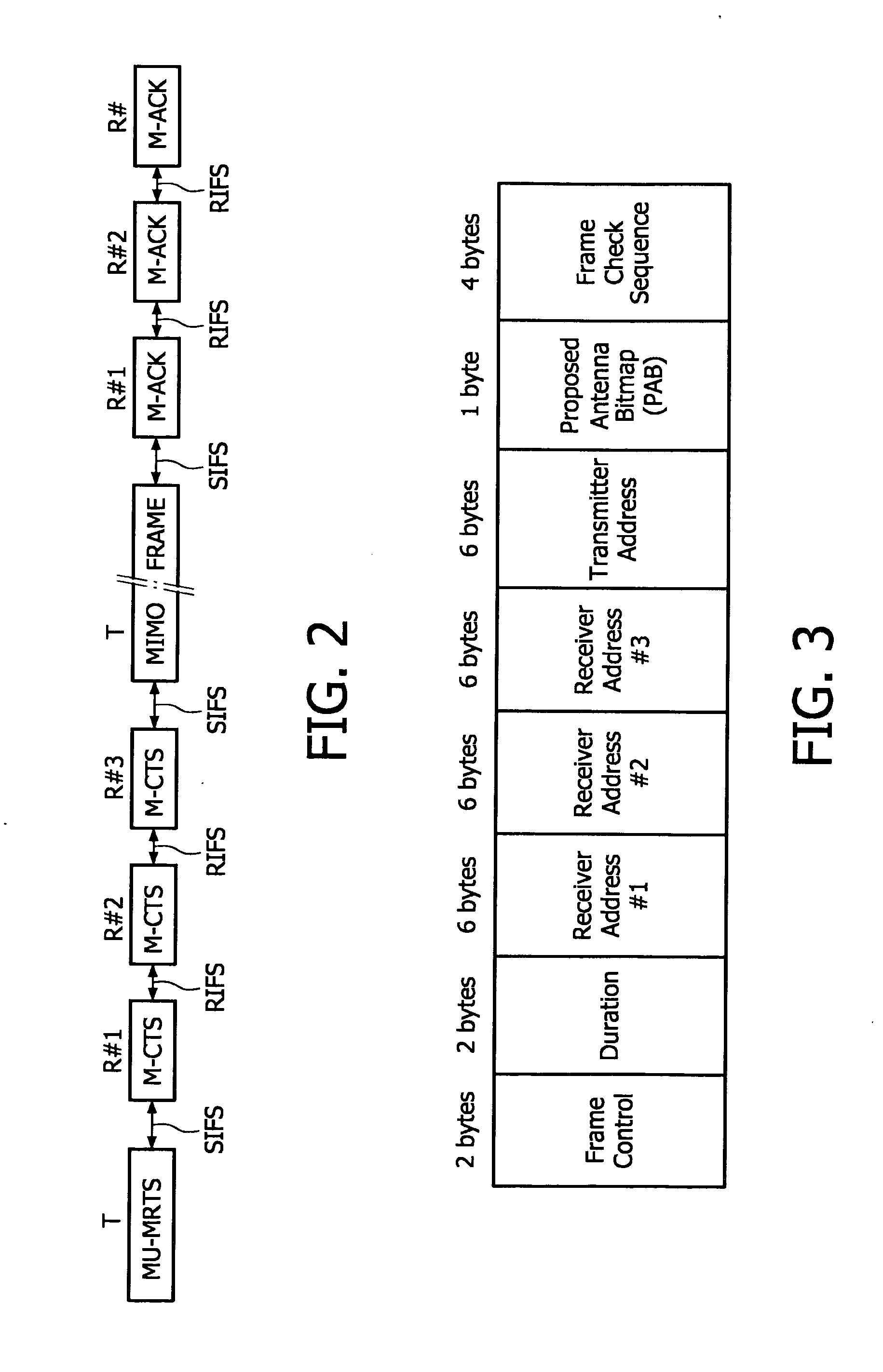Enhanced multi-user transmission
- Summary
- Abstract
- Description
- Claims
- Application Information
AI Technical Summary
Benefits of technology
Problems solved by technology
Method used
Image
Examples
first embodiment
[0055]FIG. 2 shows a four-way handshake procedure according to a The proposed MU-DCF is based on the conventional M-DCF, wherein the four-way handshake procedure is proposed to facilitate channel access with multiple users prior to data transmission.
[0056]The following additional MAC protocol functionalities are proposed during a transmission cycle in MU MIMO scenarios, compared to the conventional M-DCF protocol.
[0057]According to FIG. 2, the transmission is initiated e.g. by the AP 10 by broadcasting an MU-RTS frame as shown in FIG. 3 which is a MAC frame including multiple receiver addresses used for addressing e.g. three (R#1 to R#3) of the four exemplary stations 21 to 24 shown on FIG. 1. The MU-RTS frame can be followed by a training sequence for allowing channel estimation at the receiver side, e.g., at the selected ones of the stations 21 to 24. As an alternative option, channel estimation can also be done in parallel with the transmission of the MU-RTS frame, for example b...
second embodiment
[0077]In a second embodiment, a new MU-DCF with a two-phase channel access procedure is presented. A MU MIMO transmission is performed with beamforming support for IEEE 802.11 based networks by using MAC frames, such as MU-CFR, MIMO channel feedback (M-CF), MU-RTS and M-CTS frames, for accessing a channel, and a MAC frame M-ACK for acknowledging the correctly received packets. Optionally, an adaptive MU MIMO transmission may be performed by modifying the beamforming vectors for the MU MIMO transmission of only a subset of stations that replied with M-CTS to build the next MIMO frame. The decision can be made based on the information gained from the M-CTS frame. If the channels are already known, the MU-CFR and M-CF frames may not be necessary for the channel access mechanism of MU MIMO transmission.
[0078]MU MIMO transmission increases the spectral efficiency and provides a better utilization of resources. However, in MIMO systems, providing high throughput to multiple stations simul...
third embodiment
[0092]Because of the possibility that some stations polled for MU MIMO reception are not in each other communication range, it is proposed in the third embodiment that all stations polled for MU MIMO reception observe the end of the MU-RTS frame and calculate the duration they must wait before transmitting their M-CTS frames, taking into account the order of M-CTS transmission, the separation between each transmission, and the duration of each M-CTS transmission. A polled station then transmits its M-CTS frame after the determined duration (started from the time when the last transmission of an MU-RTS frame has been received by each station) has elapsed. While waiting to transmit the M-CTS frame, the concerned station does not need to sense the channel, because a correct reception of an MU-RTS frame implies a reserved channel between the station and the AP 10.
[0093]According to the third embodiment, the following improved procedure is proposed for setting up downlink MU MIMO transmi...
PUM
 Login to View More
Login to View More Abstract
Description
Claims
Application Information
 Login to View More
Login to View More - R&D
- Intellectual Property
- Life Sciences
- Materials
- Tech Scout
- Unparalleled Data Quality
- Higher Quality Content
- 60% Fewer Hallucinations
Browse by: Latest US Patents, China's latest patents, Technical Efficacy Thesaurus, Application Domain, Technology Topic, Popular Technical Reports.
© 2025 PatSnap. All rights reserved.Legal|Privacy policy|Modern Slavery Act Transparency Statement|Sitemap|About US| Contact US: help@patsnap.com



